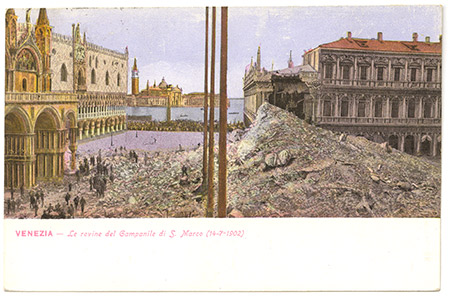Marking time in March 2016
Collapse of the campanile
Since I wrote the piece about St Mark’s Square I have added some old postcards to my collection, and discovered more about the events that lead to the collapse of the campanile in 1902.
These events were reported in detail by the Venice newspapers as they happened, and a modern journalist has compiled a detailed chronology.* Here is my summary—with acknowledgments to Google Translate and to my daughter Sally for their help in translating from Italian.
Our story begins when water was seen leaking through the roof of the small loggia at the foot of the eastern side of the tower. The Office for the Preservation of Venetian Monuments appointed the architect Domenico Rupolo to direct repair work. In June 1902 workers began to replace the lead roof sheeting of the loggetta.
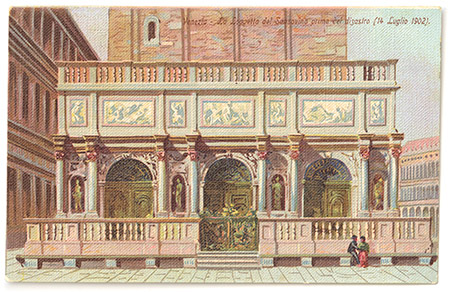
[Venice—The Loggetta of Sansovino before the disaster (14 July 1902)]. The loggetta is an elaborate marble-faced verandah attached to the base of the bell tower, designed by the architect Jacopo Sansovino, and built after 1538.
Monday 7 July—Rupolo noticed a crack in the brick wall of the tower near the roof of the loggetta and immediately reported this to the Regional Office for the Preservation of Monuments.
Tuesday 8 July—Rupolo thought the crack was getting bigger.
Wednesday 9 July—when Rupulo and his assistant Antonio Moresco looked closely at the crack they saw it was even wider, and realised that the inside of the wall was crumbling; the crack was so big a person’s hand could fit into it. For the second time, Rupolo reported to the regional office. He asked the authorities to order people out of the square.
Thursday 10 July— the crack had travelled up the wall at the north side of the windows of the tower.
Friday 11 July—one of the keepers reported stones falling inside the tower. There was a flurry of letters to and from the Regional Office for the Preservation of Monuments.
Saturday 12 July—the cracks were now visible to everybody. They had extended up to the fifth window and were getting wider. By now the Prefect of Venice had appointed a committee of engineers to deal with the emergency.
The committee determined the source of the problem: an old crack caused by a lightning strike in 1747 and subsequently repaired. To keep the tower safe while final repairs were planned, they decided to install temporary reinforcement of steel rods. A small wooden fence was built around the base of the tower to protect the many onlookers from falling rubble.
Sunday 13 July—the crack had reached the belfry. At 2 o’clock in the afternoon the committee made another inspection. They saw that all the glass tell-tales that had been fixed across the crack had broken—evidence that the crack was getting worse. At 4 o’clock the committee met the Prefect of Venice: they reported that the tower was in a serious condition. They did not think it would fall, but they did think there was a risk of a partial collapse in the following days.
The prefect ordered precautions: the tower was closed to the public and the ringing of the bells was stopped. An evening concert in the Piazza was cancelled.
Monday 14 July—at 5.30 am, Rupolo was already in the square, working out the details for the reinforcement. A new set of glass tell-tales, fixed across the crack that was repaired the day before, had all broken. The crack was getting bigger. When some rubble and larger stones fell near where he was standing, Rupolo sent the workers away.
The architect and engineer briefed the prefect who asked them how long the tower could stand; Rupolo thought a collapse was unlikely during the next four or five days. Meanwhile, in the Venice Arsenal, metal workers were making up steel cables to reinforce the corner of the tower.
Just after 9 am the committee arrived to inspect the tower, but the architect Rupolo advised them not to climb: he had seen the gap getting wider over the last three hours. The architect and his assistant could not convince the keeper of the tower, Pietro Caroncini, that he should leave his quarters inside the tower. They had to drag him out. The fence was moved, to enlarge the barricaded area around the base of the campanile.
At about 9:30 a team of firemen brought a long ladder so that the crack could be examined closely. Once the ladder was put against the tower, stones and bits of debris started falling noisily on the ground. The fireman in charge sensed that the tower might collapse at any moment. He pulled the ladder away, and drove back the onlookers who had gathered around. He shouted the order to evacuate the square, which was deserted in a few minutes, and he placed guards on the entrances to isolate the area. Meanwhile the architects ran into the nearby shops and evacuated everybody there.
At about 9:40 there were only twelve people around the tower—five municipal guards, two guards of public safety, two workers, the architect Rupolo, his assistant Moresco, and the engineer Gaspari. After a few minutes they heard a deep rumble that seemed like a groan of pain: debris erupted from the crack. The dozen people dashed away. A huge two-metre boulder came away from the corner and crashed down, followed by a shower of stones and bricks. The crack widened suddenly, spewing stones. The capstone with the angel seemed to swing in the air, until it disappeared when the bell tower collapsed on itself.
A scream rose in unison from the crowd huddled under the Procuratie Vecchie. The noise of the collapse was heard in many parts of Venice. The whole of the Piazza San Marco shook as if there had been an earthquake.
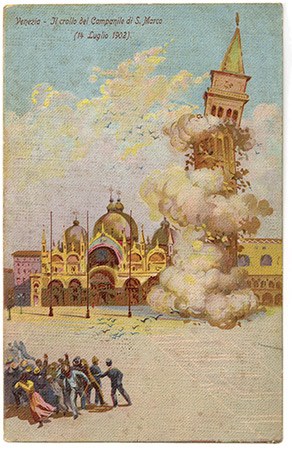
[Venice—The collapse of the bell tower of St Mark (14 July 1902)]
A dense cloud of dust rose, obscuring the sun not just in the square but from everywhere in the city. People in the distance thought it was a storm coming. The dust fell on the roofs of houses and on the streets. A stampede of curious people came to watch the engineers and city officials.
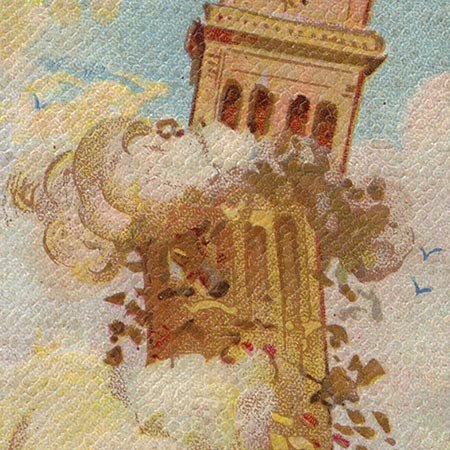
When the dust cleared the onlookers saw a conical pile of debris more than ten meters high and smelled gas gushing out from some street lamps knocked over in the square. Fortunately, because the square had been evacuated just before before the collapse, nobody was killed.
The Basilica had survived unscathed: a stout column that stood in the square had blocked the pile of debris that would otherwise have damaged the delicate corner columns of the church.
Not so the Loggia of Sansovino that was buried by the collapsing masonry. The roof of the Sansovinian Library had collapsed, along with the first floor facade, so that the interior was visible from the square.
From the rubble two symbols of the campanile emerged:
The first was the golden angel that, since 1822, had stood on top of the tower where it rotated to show the direction of the wind. It ended up in front of the main door of the basilica, smashed into many pieces.
The second was one of the large bells, which survived the collapse undamaged.
Following the collapse the people of Venice mobilised to rebuild the tower, which is a story for another day.
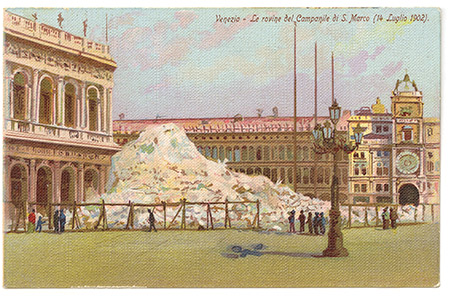
[Venice—The ruins of the bell tower of St Mark (14 July 1902)]
*The journalist Leopoldo Pietragnoli used those newspaper stories to compile a chronology, ‘Cronaca di una fine annunciata’ [Chronicle of an expected end], a chapter in the book Il Campanile di San Marco: il crollo e la ricostruzione [The Campanile of San Marco: the collapse and reconstruction] (Cinisello Balsamo: Silvana Editoriale, 1992). I did not have a copy of Pietragnoli’s book, but I have had access to Giandri’s web summary—Il campanile di San Marco—Il crollo [The campanile of San Marco—the collapse].
